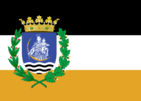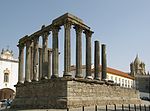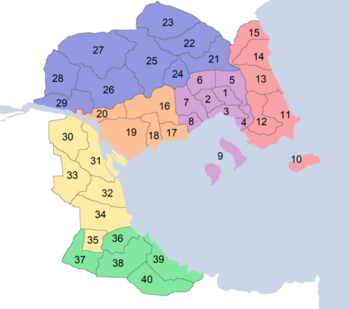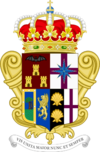Precea: Difference between revisions
| (48 intermediate revisions by 3 users not shown) | |||
| Line 4: | Line 4: | ||
| native_name = | | native_name = | ||
| native_name_lang = {{wp|Portuguese Language|Luzelese}} | | native_name_lang = {{wp|Portuguese Language|Luzelese}} | ||
| settlement_type = | | settlement_type = Capital City | ||
| image_skyline = | | image_skyline = | ||
{{Photomontage | {{Photomontage | ||
| Line 23: | Line 23: | ||
| image_caption = From top, left to right: View of Sobares Hill and the [[Bay of Precea]] • Arch of Unity at [[Tiago I Plaza]] • [[Luís Alves Bridge]] and [[Christo Rei da Precea]] • the [[Cathedral of Precea]]• [[Aurea Tower]], the [[Precea Tramway]], and [[Duarte Bórgia Bridge]] • [[Gomem Fortress]] • [[Florria Square]] • [[Primavera Palace]] the Palace of the Paretian Premier | | image_caption = From top, left to right: View of Sobares Hill and the [[Bay of Precea]] • Arch of Unity at [[Tiago I Plaza]] • [[Luís Alves Bridge]] and [[Christo Rei da Precea]] • the [[Cathedral of Precea]]• [[Aurea Tower]], the [[Precea Tramway]], and [[Duarte Bórgia Bridge]] • [[Gomem Fortress]] • [[Florria Square]] • [[Primavera Palace]] the Palace of the Paretian Premier | ||
| image_flag = | | image_flag = | ||
[[File: | [[File:PreceaFlagNew.png|border|141px]] | ||
| flag_alt = | | flag_alt = | ||
| image_seal = | | image_seal = | ||
| seal_alt = | | seal_alt = | ||
| image_shield = | | image_shield = PreceaCoANew.png | ||
| shield_alt = | | shield_alt = | ||
| etymology = | | etymology = | ||
| nickname = the Golden Citadel, the Light of The East, the City | | nickname = the Golden Citadel, the Light of The East, the Sunrise City, the City of Prayers | ||
| motto = ''Omnes Audiuntur Huc''<br> | | motto = ''Omnes Audiuntur Huc''<br> | ||
<small>"All are heard here"</small><br> | <small>"All are heard here"</small><br> | ||
| Line 44: | Line 44: | ||
| coordinates_footnotes = | | coordinates_footnotes = | ||
| subdivision_type = Country | | subdivision_type = Country | ||
| subdivision_name = {{ | | subdivision_name = {{flagicon|Paretia}}[[Paretia]] | ||
| subdivision_type1 = | | subdivision_type1 = Constituent Kingdom | ||
| subdivision_name1 = | | subdivision_name1 = {{flagicon_image|Luzflag.PNG}}[[Luzela]] | ||
| subdivision_type2 = | | subdivision_type2 = | ||
| subdivision_name2 = | | subdivision_name2 = | ||
| Line 54: | Line 54: | ||
| established_date = 200-150 BC~ | | established_date = 200-150 BC~ | ||
| founder = [[Solarian Empire]] | | founder = [[Solarian Empire]] | ||
|parts = 40 Freguesias | |||
|parts_type = {{wp|Freguesia|Freguesias}} | |||
|p1 = Cidade Velho | |||
|p2 = Cidade Centro | |||
|p3 = Princesas | |||
|p4 = Portareal | |||
|p5 = Colinaforta | |||
|p6 = Templo Solario | |||
|p7 = Sobares | |||
|p8 = Bandeira Roxa | |||
|p9 = Ilhas de Orações | |||
|p10 = Ilha dos Mestres | |||
|p11 = Silsão | |||
|p12 = Cume | |||
|p13 = Praia Precea | |||
|p14 = Lembro | |||
|p15 = Cássional | |||
|p16 = Rainha Marta | |||
|p17 = Praça País | |||
|p18 = Páteiro | |||
|p19 = Taisogâma | |||
|p20 = São Martim | |||
|p21 = Caminhario 36 | |||
|p22 = Ameixa | |||
|p23 = Specúlas | |||
|p24 = Chapéu Branco | |||
|p25 = O Vale | |||
|p26 = Fontes | |||
|p27 = Precessão | |||
|p28 = Postagem do Soldado | |||
|p29 = Cultivia | |||
|p30 = Aradorável | |||
|p31 = Boca do Veloja | |||
|p32 = Vizinhas | |||
|p33 = Fumacia | |||
|p34 = Abreu | |||
|p35 = Santa Isabela | |||
|p36 = Travessares | |||
|p37 = Novos Parques | |||
|p38 = Tereira | |||
|p39 = Santa Jacinta | |||
|p40 = Amizadeo | |||
| seat_type = | | seat_type = | ||
| seat = | | seat = | ||
| Line 124: | Line 166: | ||
| footnotes = | | footnotes = | ||
}} | }} | ||
'''Precea''' is the {{wp| | '''Precea''' is the {{wp|capital}} and {{wp|largest city}} of [[Paretia]]. It has a population of just over 3.2 million people and growing. It is located just north of the Western Strait of the [[Aurean Straits]] and [[Montecara]], on the eastern coast of [[Luzela]], at the far eastern end of the [[Euclea|Euclean]] Continent. It is the nation's cultural, political, and financial center. It has many nicknames that it is referred by in those in and outside of Paretia, such as the "Golden Citadel" (''Cidadela Dourada''), the "Light of The East" (''Luz do Oriente''), the "Sunrise City" (''Cidade do Nascer do Sol''), or the "City of Prayers" (''Cidade das Orações''). | ||
==Etymology== | ==Etymology== | ||
The name "Precea" comes from the original name of the city founded by the [[Solarian Empire|Solarians]], Preceus. The name of Preceus comes from the {{wp|Latin language|Solarian}} word ''Preces'', which means "prayers". The city of Preceus's naming derives from the location being a place where Solarian soldiers would stop during troop movements as a rest stop where many of the soldiers would use a site of {{wp|praying}}. | The name "Precea" comes from the original name of the city founded by the [[Solarian Empire|Solarians]], Preceus. The name of Preceus comes from the {{wp|Latin language|Solarian}} word ''Preces'', which means "prayers". The city of Preceus's naming derives from the location being a place where Solarian soldiers would stop during troop movements as a rest stop where many of the soldiers would use a site of {{wp|praying}}. | ||
==History== | ==History== | ||
===Foundation and Solarian Empire=== | |||
[[File:Evora-RomanTemple edit.jpg|150px|thumb|left|The Solarian temple ruins in Precea]] Little is known about the area before the [[Solarian Empire]], other than {{wp|Celtic|Tenic}} tribes and [[Piraea|Piraean]] colonies inhabiting close by. The foundation of Precea is considered to be around 250 BC, many candidates are attributed to the founding of the city, many of which being [[Solarian Empire|Solarian]] generals. The most likely candidate is [[Tullus Viridius Paullus]], a Solarian general who commanded the Solarian forces in the province of [[Aureania Inferior]], modern day south [[Luzela]], around 256 to 205 BC. | |||
The area around Precea, the mouth of the [[Velox River]], was known as a resting point for Solarian military movements between [[Euclea]] and [[Coius]]. It is said that Solarian soldiers used the stop as a site for {{wp|praying}}, hence the name, which at the time was called ''Preceus''. The city by the beginning of the 1st century was small compared to other cities on the Paretian peninsula such as [[Mausoleu|Mausoleus]] and [[Chorto]]. It became a small trade hub due to it's vicinity to the [[Aurean Straits]]. | |||
===Verliquoian Empire=== | |||
The city grew in influence during the [[Verliquoian Empire]] and eventually became the largest city on the Peninsula by the beginning of the 8th century. It became the capital of the imperial province of [[Parietie de l'Est]], located in what is modern day [[Luzela]] and [[Visega]]. The city was considered a central trade hub of the empire, and had amassed a large port, one of the largest in Euclea at the time. | |||
During the [[Tagamic Invasions]] the city was the first to fall to the invading armies, it was sacked and much of it destroyed in the war. It would continue to be under occupation and was the center of command for the invading forces until their defeat. The city continued to be a military command post in future wars against the [[Heavenly Dominions]], but Verliquoian influence on the city waned over time. By the late 10th century, various dialects and ethnicities arose across Paretia, including the [[Luzela|Luzelese]], which originated in central Luzela and became the dominant culture in the city, which eventually became their capital. | |||
===Kingdom of Luzela=== | |||
[[Luzela]] was founded by nobleman [[Henrique I]] in 1021 in Precea, breaking away from the [[Verliquoian Empire]]. During his rule he began construction of the [[Violet Fortress]] on the Nasca Ridge east of the city. Luzela began to build a large naval armada in the city and quickly rose to become the most powerful nation on the peninsula. Precea became one of the largest cities in [[Euclea]] and became a major trade hub. The Luzelese began to use {{wp|caravels}} in the cities ports for exploration and long-distance trade, and continued to have a close relationship to sailors, city began to give privileges and protections to sea traders and sailors, making the city a competitive hub for sailors across the world. | |||
During the [[13th and 14th Century Crisis]], the throne of the [[House of Bússolo]] collapsed due to warfare within the house itself, this would lead to a period of upheaval in the city and multiple uprisings by the lower classes against the nobility. By the end of the crisis the [[House of Azulejeiras]] would be entrusted to rule the country. During this time the city began to compete with others in trade as Luzela began to compete with the rising [[Esmeira|Esmeirans]] for the role of being the central power of the peninsula. The city became the launching point for many explorations eastward, notably in [[Coius]]. After the discovery of the [[Asterias]] the city became a major port for sending out fleets for colonization of the new world. Competing with Esmeira also in colonization. The city's important in Eastern Euclea lead to the name "Light of The East" (''Luz do Oriente'') and the "Sunrise City" (''Cidade do Nascer do Sol''). | |||
During the rule of Queen [[Marta I]] she began the construction of the [[Sunrise Palace]], during the [[Paretian War]] the city saw little fighting but grew immensely as Marta I cemented Luzela's control of the peninsula, the city would then became the capitol of the [[Paretia|United Kingdom of Paretia]]. | |||
[[File:CastleSaintGeorge.jpg|700px|thumb|center|The [[Violet Fortress]] in the Colinaforta district, built during the early Luzelese kingdom, was the palace of the Luzelese monarchy until the 16th century.]] | |||
===Early Modern=== | |||
[[File:Ruinas da Sé de Lisboa após o Terramoto de 1755 - Jacques Philippe Le Bas, 1757.png|200px|thumb|right|The [[1768 Luzela Earthquake]] destroyed much of Precea, including the [[Sunrise Palace]], home of the monarchy.]] | |||
[[File:Landing of liberal forces in Oporto.jpg|175px|thumb|left|Paretian troops landing in Precea to subdue revolutionaries, 1820.]] | |||
===Industrialization=== | |||
[[File:Graca cable tram.jpg|200px|thumb|right|The [[Tram of Precea]] being used after its completion in 1903]] | |||
===Great War=== | |||
===20th century=== | |||
===Modern=== | |||
==Government== | ==Government== | ||
[[File:Mariana Vieira da Silva (Assim é Portugal), cropped.png|200px|thumb|left|[[Roxana Alvim]] has served as [[Mayor of Precea|Mayoress of Precea]] since 2018]] [[File:Lisbon City Hall and pillory (3906350050).jpg|300px|thumb|right|Precea Administrative Building in the Cidade Centro district]] The city has a special status as the | [[File:Mariana Vieira da Silva (Assim é Portugal), cropped.png|200px|thumb|left|[[Roxana Alvim]] has served as [[Mayor of Precea|Mayoress of Precea]] since 2018]] [[File:Lisbon City Hall and pillory (3906350050).jpg|300px|thumb|right|Precea Administrative Building in the Cidade Centro district]] The city has a special status as the capital and largest city of [[Paretia]], but its government functions not much different from other major cities in the united kingdom. Today it serves as both the capitol of [[Luzela]] and [[Paretia]], having both the administrations of the Kingdom of Luzela and the United Kingdom in the city. | ||
The city's {{wp|legislature}} is the [[Precea City Council|city council]], which has 10 members and works alongside the mayor. The city council and office of the mayor are ran at the [[Precea Administrative Building]]. Each with a two year term, they vote on laws and bills for the city. | |||
The {{wp|execvutive}} is the officer of the [[Mayor of Precea|mayor]], who leads the party with the most seats on the city council. They have a two year term and maintain the government of the city. | |||
The {{wp|judiciary}} is the [[Court of Precea]]. It deals with criminal and law cases in the city and has a judge that is appointed or voted in. This court runs the city's {{wp|comarca}}. | |||
===Subdivisions=== | ===Subdivisions=== | ||
The city is divided into 6 regions, East, East | The city is divided into 6 regions, East, East Central, West Central, North, West, and South. These regions are further divided into 40 {{wp|freguesia|freguesias}}. East-Central is where the old city is located and is the city center. West-Central is where much of the financial district is located. The North and West regions are mostly populated with lower class to middle class people. The East and South regions are more upper class. | ||
{| style="margin: 1em auto;" | {| style="margin: 1em auto;" | ||
|- | |- | ||
| Line 139: | Line 216: | ||
{| style="margin:auto;" cellpadding="15" | {| style="margin:auto;" cellpadding="15" | ||
|- | |- | ||
| [[File: | | [[File:Preceadistricts.png|350px|border|left]] | ||
{| class="wikitable" | {| class="wikitable" | ||
|- | |- | ||
| Line 243: | Line 320: | ||
| | | | ||
| 8 | | 8 | ||
| | | Bandeira Roxa | ||
| | | | ||
| | | | ||
| Line 272: | Line 349: | ||
==Culture== | ==Culture== | ||
==Sister Cities== | ==Sister Cities== | ||
{| CELLPADDING=0 width="100%" | |||
|- VALIGN=top | |||
|width="33%"| | |||
* {{flagicon|Etruria}} [[Povelia]] (1968) | |||
* {{flagicon|Imagua and the Assimas}} [[Cuanstad]] (1993) | |||
* {{flagicon image|Ardesiaflag.png}} [[Rémont]] (1994) | |||
* {{flagicon|Gaullica}} [[Rayenne]] (2004) | |||
|width="33%"| | |||
* {{flagicon|Paretia}} [[Ocerto]] (1951) | |||
* {{flagicon|Paretia}} [[Encerosa]] (1951) | |||
* {{flagicon|Estmere}} [[Morwall]] (1988; [[Morwall#Other_relationships|non-sister relationship]]) | |||
* {{flagicon|Etruria}} [[Solaria]] (1970) | |||
|} | |||
{{Template:Paretia topics}} | {{Template:Paretia topics}} | ||
Latest revision as of 03:10, 30 December 2023
This article is incomplete because it is pending further input from participants, or it is a work-in-progress by one author. Please comment on this article's talk page to share your input, comments and questions. Note: To contribute to this article, you may need to seek help from the author(s) of this page. |
Precea | |
|---|---|
Capital City | |
From top, left to right: View of Sobares Hill and the Bay of Precea • Arch of Unity at Tiago I Plaza • Luís Alves Bridge and Christo Rei da Precea • the Cathedral of Precea• Aurea Tower, the Precea Tramway, and Duarte Bórgia Bridge • Gomem Fortress • Florria Square • Primavera Palace the Palace of the Paretian Premier | |
| Nickname(s): the Golden Citadel, the Light of The East, the Sunrise City, the City of Prayers | |
| Motto(s): Omnes Audiuntur Huc "All are heard here" | |
| Country | |
| Constituent Kingdom | |
| Founded | 200-150 BC~ |
| Founded by | Solarian Empire |
| Freguesias | 40 Freguesias
|
| Government | |
| • Type | City |
| • Body | Council of Precea |
| • Mayoress | Roxana Alvim (Vs) |
| Population (2020) | |
| • Total | 3,243,102 |
Precea is the capital and largest city of Paretia. It has a population of just over 3.2 million people and growing. It is located just north of the Western Strait of the Aurean Straits and Montecara, on the eastern coast of Luzela, at the far eastern end of the Euclean Continent. It is the nation's cultural, political, and financial center. It has many nicknames that it is referred by in those in and outside of Paretia, such as the "Golden Citadel" (Cidadela Dourada), the "Light of The East" (Luz do Oriente), the "Sunrise City" (Cidade do Nascer do Sol), or the "City of Prayers" (Cidade das Orações).
Etymology
The name "Precea" comes from the original name of the city founded by the Solarians, Preceus. The name of Preceus comes from the Solarian word Preces, which means "prayers". The city of Preceus's naming derives from the location being a place where Solarian soldiers would stop during troop movements as a rest stop where many of the soldiers would use a site of praying.
History
Foundation and Solarian Empire
Little is known about the area before the Solarian Empire, other than Tenic tribes and Piraean colonies inhabiting close by. The foundation of Precea is considered to be around 250 BC, many candidates are attributed to the founding of the city, many of which being Solarian generals. The most likely candidate is Tullus Viridius Paullus, a Solarian general who commanded the Solarian forces in the province of Aureania Inferior, modern day south Luzela, around 256 to 205 BC.
The area around Precea, the mouth of the Velox River, was known as a resting point for Solarian military movements between Euclea and Coius. It is said that Solarian soldiers used the stop as a site for praying, hence the name, which at the time was called Preceus. The city by the beginning of the 1st century was small compared to other cities on the Paretian peninsula such as Mausoleus and Chorto. It became a small trade hub due to it's vicinity to the Aurean Straits.
Verliquoian Empire
The city grew in influence during the Verliquoian Empire and eventually became the largest city on the Peninsula by the beginning of the 8th century. It became the capital of the imperial province of Parietie de l'Est, located in what is modern day Luzela and Visega. The city was considered a central trade hub of the empire, and had amassed a large port, one of the largest in Euclea at the time.
During the Tagamic Invasions the city was the first to fall to the invading armies, it was sacked and much of it destroyed in the war. It would continue to be under occupation and was the center of command for the invading forces until their defeat. The city continued to be a military command post in future wars against the Heavenly Dominions, but Verliquoian influence on the city waned over time. By the late 10th century, various dialects and ethnicities arose across Paretia, including the Luzelese, which originated in central Luzela and became the dominant culture in the city, which eventually became their capital.
Kingdom of Luzela
Luzela was founded by nobleman Henrique I in 1021 in Precea, breaking away from the Verliquoian Empire. During his rule he began construction of the Violet Fortress on the Nasca Ridge east of the city. Luzela began to build a large naval armada in the city and quickly rose to become the most powerful nation on the peninsula. Precea became one of the largest cities in Euclea and became a major trade hub. The Luzelese began to use caravels in the cities ports for exploration and long-distance trade, and continued to have a close relationship to sailors, city began to give privileges and protections to sea traders and sailors, making the city a competitive hub for sailors across the world.
During the 13th and 14th Century Crisis, the throne of the House of Bússolo collapsed due to warfare within the house itself, this would lead to a period of upheaval in the city and multiple uprisings by the lower classes against the nobility. By the end of the crisis the House of Azulejeiras would be entrusted to rule the country. During this time the city began to compete with others in trade as Luzela began to compete with the rising Esmeirans for the role of being the central power of the peninsula. The city became the launching point for many explorations eastward, notably in Coius. After the discovery of the Asterias the city became a major port for sending out fleets for colonization of the new world. Competing with Esmeira also in colonization. The city's important in Eastern Euclea lead to the name "Light of The East" (Luz do Oriente) and the "Sunrise City" (Cidade do Nascer do Sol).
During the rule of Queen Marta I she began the construction of the Sunrise Palace, during the Paretian War the city saw little fighting but grew immensely as Marta I cemented Luzela's control of the peninsula, the city would then became the capitol of the United Kingdom of Paretia.

Early Modern

Industrialization

Great War
20th century
Modern
Government
The city has a special status as the capital and largest city of Paretia, but its government functions not much different from other major cities in the united kingdom. Today it serves as both the capitol of Luzela and Paretia, having both the administrations of the Kingdom of Luzela and the United Kingdom in the city.
The city's legislature is the city council, which has 10 members and works alongside the mayor. The city council and office of the mayor are ran at the Precea Administrative Building. Each with a two year term, they vote on laws and bills for the city.
The execvutive is the officer of the mayor, who leads the party with the most seats on the city council. They have a two year term and maintain the government of the city.
The judiciary is the Court of Precea. It deals with criminal and law cases in the city and has a judge that is appointed or voted in. This court runs the city's comarca.
Subdivisions
The city is divided into 6 regions, East, East Central, West Central, North, West, and South. These regions are further divided into 40 freguesias. East-Central is where the old city is located and is the city center. West-Central is where much of the financial district is located. The North and West regions are mostly populated with lower class to middle class people. The East and South regions are more upper class.
| |||||||||||||||||||||||||||||||||||||||||||||||||||||||||||||||||||||||||||||||||||||||||||||||||||||||||||||||||||||||||
Demographics
Culture
Sister Cities
|
|















